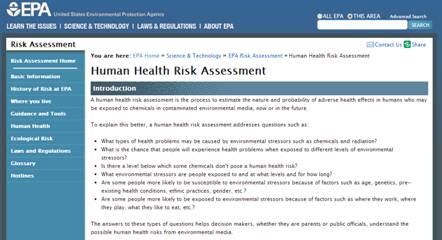Human health risk assessment
The objectives of a risk assessment are generally the same:
To identify if either:
- An area containing chemicals may be toxic to humans;
OR
- A specific chemical is toxic, and if so, at what concentration.
If a chemical might be toxic at the level present at a site, then a third goal would be to identify how much cleanup is necessary to protect human health.
Because the goals are similar across all risk assessments, the general methodology has been standardized in the United States by the U.S. EPA. Risk assessment has been similarly standardized in other regions, including Europe. The standardized human health risk assessment methodology generally includes the following four broad but interrelated components:
- Hazard identification / Data collection and evaluation - in this step, the conditions at the site are identified, and information about the chemicals present at the site are used to identify the concentrations at which humans could be exposed as well as the spatial extent of contamination. This step is common to qualitative and quantitative risk assessment.
- Dose-response assessment - Dose-response is a quantitative risk assessment process, and primarily involves the characterization of the relationship between chemical potency and incidence or severity of an adverse health effect in the exposed population. Therefore, in this step, appropriate toxicity values are determined for different exposure routes to define the potency of a chemical to humans.
- Exposure assessment - in this phase, the identification of how human populations could contact with the chemicals is done, and the possible doses resulting from assumed levels of exposure are estimated. This step also includes identifying the types of human populations that could be exposed and the potential exposure routes (e.g., ingestion, inhalation).
- Risk characterization - All the information derived from the three steps of the risk assessment process referred above is used in this last step. Thus, the dose estimates and toxicity values (i.e., a variety of data) are combined to generate a risk value for each chemical. These risk values are compared with target risk values that are typically identified by regulatory agencies to define an "acceptable" risk. Although the process is formalized, the characteristics will change depending on the conditions that are relevant for a given site and situation.
Based on the risk characterization, the need for and the degree of risk management will be determined. A number of options are available to the risk manager, including education and risk communication (e.g. to the public), limitations in the use of the substance of concern or a total ban of the chemical, exposure monitoring and controls. Risk management decisions are influenced by economic, social, and political concerns. Thus, the results from the human health risk assessment are used to inform risk management.
Some of the problematic areas in human health risk assessment are listed below:
- Animal to human extrapolation;
- High to low dose extrapolation;
- Threshold versus nonthreshold dose-response;
- Extrapolating laboratory data to the field;
- Extrapolating cell culture results to a whole organism;
- Estimates of exposure;
- Interactions across chemicals;
- Toxicity of complex mixtures;
- Definition of "acceptable" risk.
More information on human health risk assessment can be found in the following link of U.S. Environmental Protection Agency:
http://www.epa.gov/risk_assessment/health-risk.htm
REFERENCES
Derelanko MJ, Hollinger MA. (2002). Handbook of toxicology. 2nd edition. CRC Press LLC, Florida, United States. 1380p.
Hayes AW, Kruger CL. (2014). Hayes' Principles and Methods of Toxicology. 6th edition. CRC Press, London, UK. 2112p.
Hodgson E. (2010). A textbook of modern toxicology. 4th edition. John Wiley & Sons, Inc., Hoboken, New Jersey. 648p.
Stelljes ME. (2008). Toxicology for Non-toxicologists. 2nd edition. The Scarecrow Press, Inc, Lanham, Maryland, USA. 207p.
U.S. Environmental Protection Agency (1998). Guidelines for Ecological Risk Assessment, Washington, D.C., Fed. Reg., 63(93), 26846-26924.
Walker C. (2014). Ecotoxicology. Effects of Pollutants on the Natural Environment. CRC Press, Boca Raton, United States. 230p.
Williams PL, James RC, Roberts SM. 2000. Principles of toxicology. Environmental and Industrial Applications. 2nd edition. John Wiley & Sons, Inc., New York, USA. 603p.
